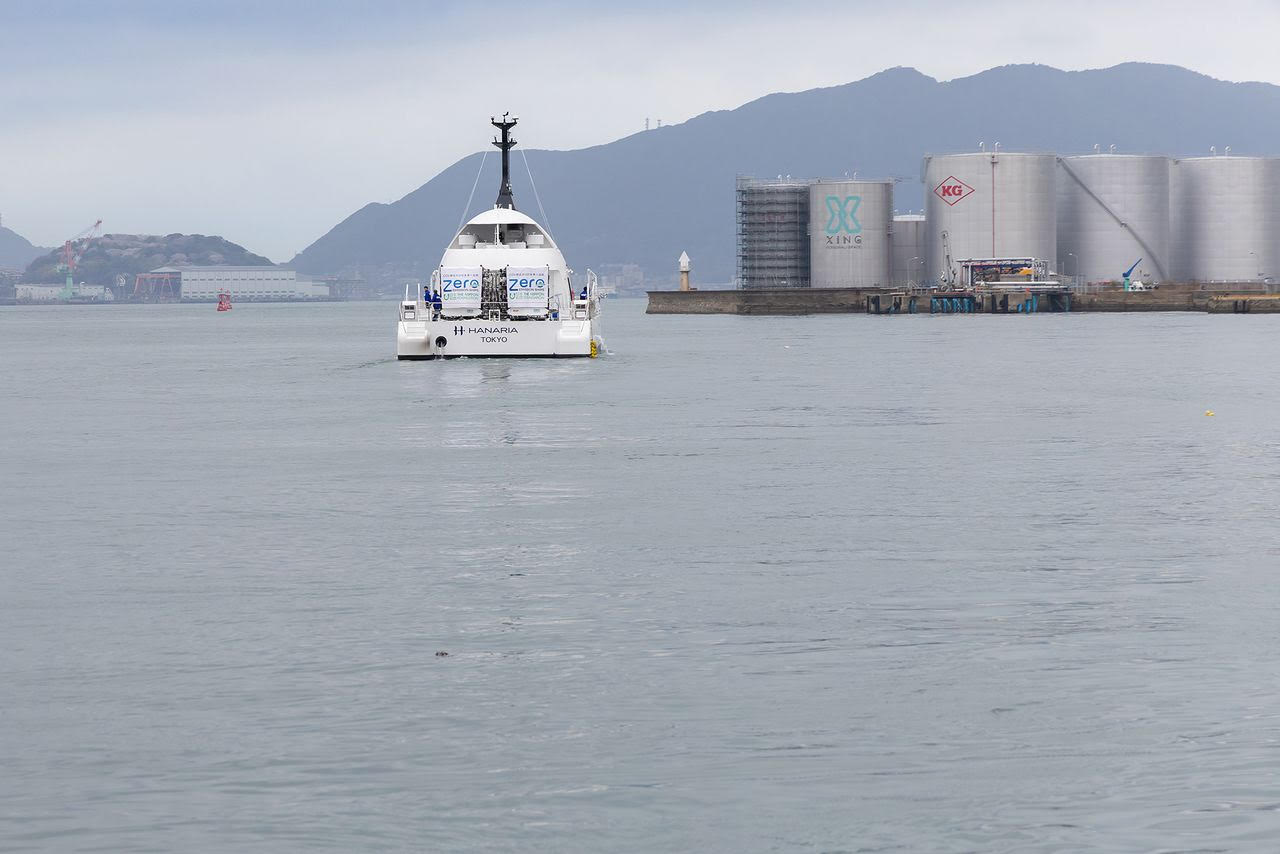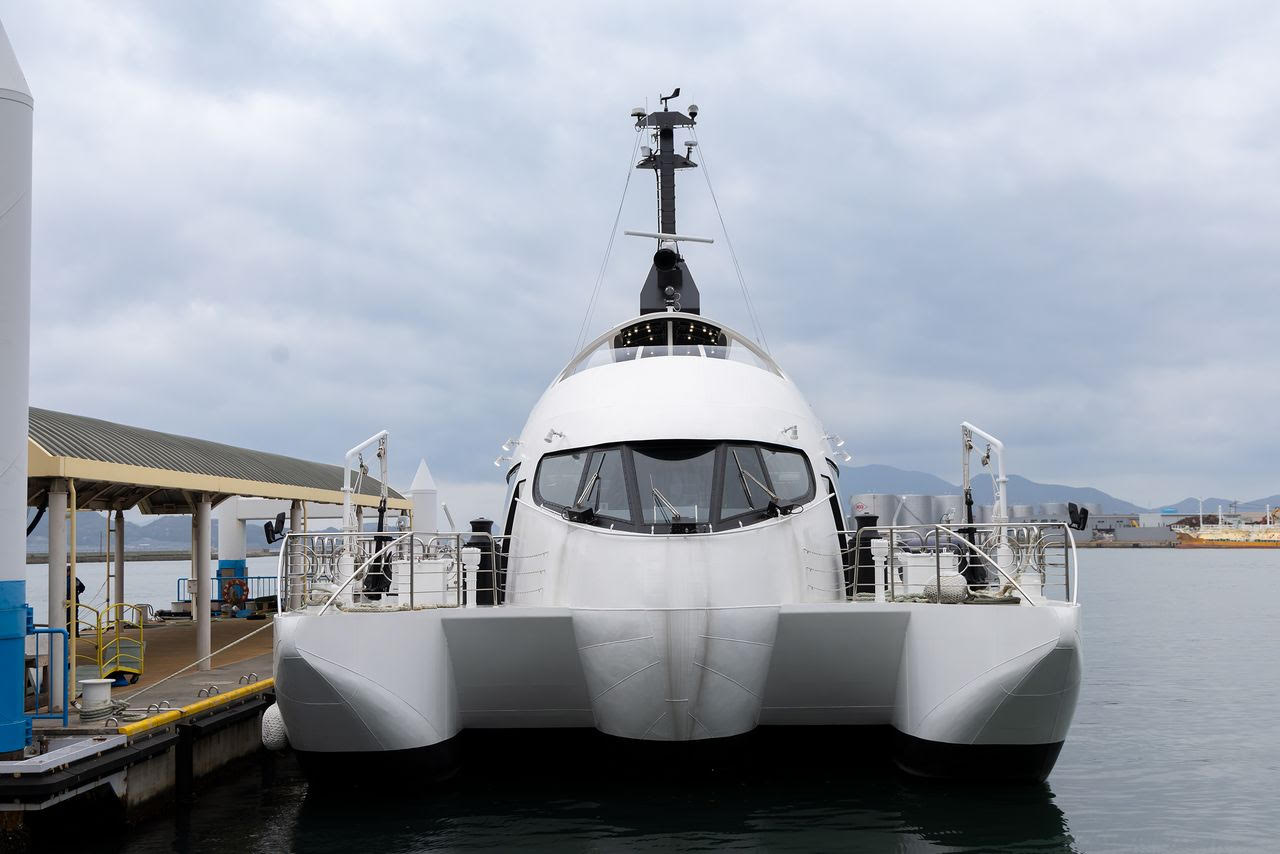
Hybrid electric ship the Hanaria successfully completed a zero-emission test in April, demonstrating how it is possible to reduce emissions within Japan’s transport sector.
Fuel Cell First
The Hanaria, a ship powered by both hydrogen and biodiesel, underwent certification between March 26 and April 4, 2024, an exercise that saw it sailing between Kokura Port in Kitakyūshū and a wind farm located off the city’s Wakamatsu Ward. The vessel successfully completed the 57-kilometer return voyage in three hours and 45 minutes without emitting any carbon dioxide whatsoever.

The Hanaria on its zero-emission certification voyage. (Courtesy Nippon Foundation)
Developed as part of the Nippon Foundation’s zero-emission shipping project, the Hanaria is 33 meters long and 10 meters wide, weighs 238 tons, and is certified to carry up to 100 people. A “hybrid electric” vessel, the boat is equipped with two hydrogen fuel cells, a generator that runs on biodiesel, and two lithium-ion batteries. The recent voyage represented not only the first successful certification voyage of a Japanese hydrogen-powered vessel weighing 20 tons or more, but also the first zero-emission voyage ever performed by a wind-farm service vessel anywhere in the world.
At a demonstration voyage for guests held in the harbor before the press conference, the Hanaria operated in hybrid mode when departing from the wharf, a part of the journey that is energy-intensive. Even then, the ship was quiet, and passengers felt little vibration. The ship then switched to zero-emission mode, causing the engine to fall silent as the ship accelerated away as if gliding over the water. There was no distinctive smell of marine fuel, something that means that in addition to being good for the environment, the Hanaria also looks set to help passengers feel less seasick.

The Hanaria docked at Sunatsu wharf. In hybrid mode, the vessel’s CO2 emissions are 53% less than those of a conventional ship. (© Nippon.com)

In zero-emission mode, the Hanaria leaves hardly any wake when cruising at low speeds. (© Nippon.com)
Driving the Global Shift to Zero-Emission Shipping
Japan’s carbon emissions totaled 1.06 billion tons in fiscal 2021, of which a whopping 17.4% were produced by the transport sector: automobiles (including private cars), aviation, and shipping. The Nippon Foundation’s zero-emission shipping project aims to eliminate carbon emissions from coastal shipping, which currently represent 5.5% of all transport emissions. Since 2022, three consortia have been working to develop zero-emission ships. The latest voyage was accomplished by the consortium for the design of hydrogen fuel-cell-powered wind-farm service vessels, which comprises Motena-Sea, MOL Techno-Trade, Hongawara Ship Yard, Kanmon-Kisen, and Taiyō Nippon Sanso.
Commenting on the success of the voyage, Nippon Foundation Executive Director Unno Mitsuyuki said, “Zero-emission shipping is a key part of creating a carbon-neutral society by 2050. Japan has more hydrogen patents than any other country in the world. We hope to pool this technical expertise and use it to lead the global shipping industry to carbon neutrality.”

Nippon Foundation Executive Director Unno Mitsuyuki, Motena-Sea CEO Takao Kazutoshi, Toyota’s Hamamura Yoshihiko, and Kitakyūshū Mayor Takeuchi Kazuhisa at the press conference. (© Nippon.com)
Fuel cell and hydrogen storage technology for the project was provided by Toyota, which is the producer of the Mirai, the world’s first mass-produced fuel cell vehicle, as well as the owner of many hydrogen-related patents.
Hamamura Yoshihiko, who leads the team project at Toyota subsidiary Hydrogen Factory, said, “This project has carved out two major paths towards the creation of a carbon neutral society. Firstly, it aims to make an entry into the shipping sector at a time when most other Japanese hydrogen shipping projects are still at the experimental stage. Secondly, because hydrogen propulsion is a new technology, the regulatory framework has not yet caught up with it. By proactively lobbying related stakeholders, we have achieved some operational improvements that will make things easier for subsequent shipping projects.”
While the Hanaria was developed as a crew transfer vessel for offshore wind farms, which are seen as a promising renewable energy solution, Unno explains that, “Because there are currently not that many working offshore wind farms, the vessel will carry passengers for the time being.”
Data collected over the course of the ship’s operations will be used to make design improvements and enable further deregulation.

The hydrogen tanks at the rear of the vessel are loaded by crane. (© Nippon.com)

Controls on the bridge of the Hanaria allow the captain to switch between hybrid and zero-emission modes. (© Nippon.com)
Hydrogen-Powered Cruises
However, obstacles stand in the way of commercialization. For example, it is currently not possible to procure hydrogen fuel in Kitakyūshū, and the need to transport the fuel from Fukuoka adds to costs.
Motena-Sea CEO Takao Kazutoshi says, “Ideally hydrogen should be used at the location of manufacture. We’d like to see local hydrogen production happening in the near future. This project involves a lot of firsts, so there are obviously a lot of challenges as well.”
Takao continued confidently, “We hope to become pioneers in the building of zero-emissions ships by beginning commercial operations as soon as possible.”
Cooperation between the public and private sectors will be important, as evidenced by the comments of Kitakyūshū Mayor Takeuchi Kazuhisa, who said, “We’re trying to bring together the broader wind power industry and otherwise work toward carbon neutrality. We have also jointly established with the prefectural government a council to build a major hub for the supply and utilization of hydrogen.”

Quiet, and equipped with projectors and large screen displays, the Hanaria is ideal for hosting seminars and other events. (© Nippon.com)
The Hanaria will begin its working life by ferrying passengers between Kokura and Moji Ports. The vessel will be deployed on a cruise that takes passengers under the Kanmon Bridge before giving them views of the city of Shimonoseki, Ganryū Island, and Karato Market, as well as a cruise that allows passengers to visit temples and shrines by sea, and a nighttime cruise for those who want to see the lights of factories in operation. Fares range from ¥5,500 to ¥11,000.
Motena-Sea CEO Takao thinks the future is bright. “We’re seeing a lot of interest. We’ve received inquiries from several local bodies interested in using this ship. For the moment, however, we want passengers to see how pleasant a zero-emission voyage can be on the Hanaria. We believe this will be a step towards the early achievement of carbon neutrality.”
During fiscal 2026, the Nippon Foundation zero-emission ship project plans to trial hydrogen-powered passenger vessels and tankers.

The Hanaria’s open-plan upper deck allow passengers to enjoy the view while feeling the salt spray. (© Nippon.com)

The Hanaria’s sleek design is also likely to be popular with passengers. (© Nippon.com)
(Originally published in Japanese. Photos by Hashino Yukinori of Nippon.com. Banner photo: The Hanaria is the first large Japanese maritime vessel to run on hydrogen fuel cells.)
SOURCE: nippon.com
Read the most up to date Fuel Cell and Hydrogen Industry news at FuelCellsWorks




